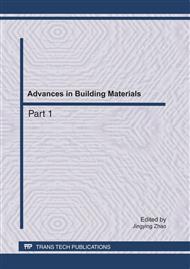[1]
V. Ramakrishnan, G.Y. Wu and G. Hosalli, "Flexural Behavior and Toughness of Fiber Reinforced Concretes," Transportation Research Record 1226, Transportation Research Board, Washington DC, USA.
Google Scholar
[2]
J.F. Trottier, M. Mahoney, "Innovative Synthetic Fibers," Concrete International, Volume 23, Issue 6(2001), PP.23-28, American Concrete Institute, Michigan, USA.
Google Scholar
[3]
R.F. Zollo, and C.D. Hays, "Fibers versus WWF as Non-Structural Slab Reinforcement," Concrete International, Vol. 13, No. 11, 1991, PP.50-55. American Concrete Institute, Michigan, USA.
Google Scholar
[4]
E. Hognestad, E. (1951). "A Study of Combined Bending and Axial Load in Reinforced Concrete Members." Bulletin No. 399, 1951, Engineering Experiment Station, University of Illinois, Urbana.
Google Scholar
[5]
P. Desayl and S. Krishnan, "Equation for the Stress-Strain Curve of Concrete," ACI Journal, Proceeding, Vol. 61, No. 3, 1964, pp.345-350.
Google Scholar
[6]
P. T. Wang, S. P. Shah and A.E. Naaman, "Stress-Strain Curves of Normal and Lightweight Concrete in Compression," ACI Journal, Proceediig, 75(11), 1978, pp.603-611.
DOI: 10.14359/10973
Google Scholar
[7]
D. J. Carreira and K. H. Chu, "Stress-Strain Relationship for Plain Concrete in Compression," ACI Journal Proceedings, 82(6), 1985, PP. 797-804.
Google Scholar
[8]
A. Ezeldin, and N. Balaguru, "Normal- and high-strength fiber-reinforced concrete under compression," Journal of Materials in Civil Engineering, vol. 4, No.4 Paper No. 170, November 1992. American Society of Civil Engineering (ASCE).
DOI: 10.1061/(asce)0899-1561(1992)4:4(415)
Google Scholar
[9]
Chinese Ministry of Communication, "Standard Test Method for Compressive Strength of Cubic Concrete Specimens T0553-2005" Test Methods of Cement and Concrete for Highway Engineering," JTG E30-2005, Ministry of Communication, Beijing, China (2005). (In Chinese)
Google Scholar
[10]
H.T. Hu, F.M. Lin and Y. Y. Jan, "Nonlinear finite element analysis of reinforced concrete beams strengthened by fiber-reinforced plastics," Composite Structures, Vol. 63, 2004, PP. 271-281.
DOI: 10.1016/s0263-8223(03)00174-0
Google Scholar
[11]
http://www.oakdaleengr.com/
Google Scholar


